
Kidney dissection illustrating the internal and external structural components. Urine formation discussed briefly as well.
- Subject:
- Anatomy/Physiology
- Life Science
- Material Type:
- Simulation
- Author:
- Dr. Hamid Nawz
- Date Added:
- 04/26/2022

Kidney dissection illustrating the internal and external structural components. Urine formation discussed briefly as well.

Students learn about the anatomy of the ear and how the ears work as a sound sensor. Ear anatomy parts and structures are explained in detail, as well as how sound is transmitted mechanically and then electrically through them to the brain. Students use LEGO® robots with sound sensors to measure sound intensities, learning how the NXT brick (computer) converts the intensity of sound measured by the sensor input into a number that transmits to a screen. They build on their experiences from the previous activities and establish a rich understanding of the sound sensor and its relationship to the TaskBot's computer.
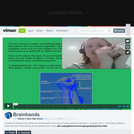
This is a 6 minute video lesson about memorizing the parts of the brain using your hands. It was created for a Psychology class and focuses on learning about where each major part of the brain is located. It's based off of the work found here: http://www.pbs.org/wgbh/nova/coma/geography/photos.html.
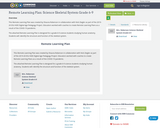
This Remote Learning Plan was created by Shauna Roberson in collaboration with Nick Ziegler as part of the 2019-20 ESU-NDE Digital Age Pedagogy Project. Educators worked with coaches to create Remote Learning Plans as a result of the COVID-19 pandemic.The attached Remote Learning Plan is designed for a grade 6-9 science students studying human anatomy. Students will: identify the structure and function of the skeletal system.
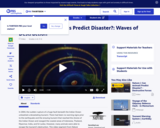
Learn about the anatomy of a tsunami in this segment from Nature.
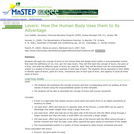
This activity is an introduction to the concept of levers, the classes, and their parts using the musculoskeletal system.

Short Description:
An English translation of a 1918 work by German veterinary anatomist Dr. Hermann Baum, The Lymphatic System of the Dog details a comprehensive investigation of the anatomy and drainage patterns of the canine lymphatic system. Despite being written over 100 years ago, much of Dr. Baum's exhaustive work has not been repeated and is still relevant today. The book is organized into two main sections: the first details the anatomical location and drainage pathways of lymph nodes, while the second describes the lymphatic drainage pathways of major organs. This information is applicable to the diagnosis and treatment of canine patients as well as to researchers investigating the lymphatic system in dogs and in humans. In addition to translating the original work, the University of Saskatchewan team of faculty and students has added notes describing key clinical points, as well as interactive student learning tools, including flashcards on lymphatic drainage patterns in canine cancer patients and lymph node labelling exercises. Our goal in translating this textbook was to honour the legacy of Dr. Baum's extensive work and to make this valuable information freely accessible to English-speaking veterinary students, teachers, veterinarians, and researchers. The PDF print version is available for download here: The Lymphatic System of the Dog
Long Description:
The book is organized into two main sections: the first details the anatomical location and drainage pathways of lymph nodes, while the second describes the lymphatic drainage pathways of major organs. This information is applicable to the diagnosis and treatment of canine patients as well as to researchers investigating the lymphatic system in dogs and in humans.
In addition to translating the original work, the University of Saskatchewan team of faculty and students has added notes describing key clinical points, as well as interactive student learning tools, including flashcards on lymphatic drainage patterns in canine cancer patients and lymph node labelling exercises. Our goal in translating this textbook was to honour the legacy of Dr. Baum’s extensive work and to make this valuable information freely accessible to English-speaking veterinary students, teachers, veterinarians, and researchers.
The digital print version is available for download here: The Lymphatic System of the Dog PDF
Word Count: 73969
(Note: This resource's metadata has been created automatically by reformatting and/or combining the information that the author initially provided as part of a bulk import process.)

This Remote Learning Plan was created by Shauna Roberson in collaboration with Nick Ziegler as part of the 2019-20 ESU-NDE Digital Age Pedagogy Project. Educators worked with coaches to create Remote Learning Plans as a result of the COVID-19 pandemic.The attached Remote Learning Plan is designed for a grade 6-9 science students studying human anatomy. Students will: make a claim that is supported by evidence and reasoning on which body system is most important.

This resource in an activity for sports medicine or health science students with an understanding of anatomy, physiology, common disorders and injuries to the musckeloskeletal system and techniques of assessing injuries including obtaining medical histories and evaluating techniques. This resource provided a template for students to use when practicing technical skills needed for assessment of a knee injury.

In anatomy, form and function of sensory organs allows students to understand how the body interacts with external stimuli. Explorations of the eye and ear often lack a full exploration of the physical science phenomena behind them. In this unit, both the eye and ear are explored as receptors for wave phenomena of light and sound. The interaction between anatomy and physical science provides a robust understanding of how the body functions. In addition to a brief study of waves, students will also explore medical interventions such as the bionic eye, glasses, hearing aids, and cochlear implants as ways to improve our ability to sense sight and sound.
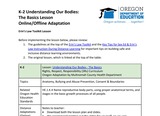
The Oregon Department of Education released this online and offline lesson adaptation, as a part of the Distance Learning for All Erin's Law Toolkit for Districts. The lesson is an Advocates for Youth Rights, Respect, Responsibility (3Rs) Kindergarden lesson entitled Understanding Our Bodies: The Basics. The full lesson has been adapted by Mulnomah County Health Department to be more trauma-informed, more trans-inclusive, and to prompt more discussion about race and racism. This lesson focuses on the core sexuality education topics: Anatomy, Bullying and Abuse Prevention, Consent & Boundaries, which are each foundational to child abuse prevention education. 3Rs Original Authors: Elizabeth Schroeder EdD MSW, Eva Goldfarb PhD, Nora Gelperin MEd
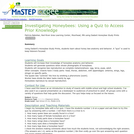
This activity is a presentation of honeybee anatomy and behavior.
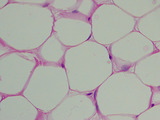
CT_adipose_kidney_630x, p000137
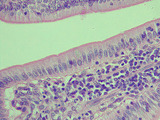
simple columnar epi with goblet cells_intestine_630x, p000139
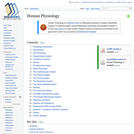
Physiology The word physiology is from the Ancient Greek φυσιολογία (phusiología, "natural philosophy") and it is the study of how organisms perform their vital functions. An example is the study of how a muscle contracts or the force contracting muscles exert on the skeleton. It was introduced by French physician Jean Fernery in 1552. Physiology is built upon a tripod of sciences: physics, chemistry, and anatomy.
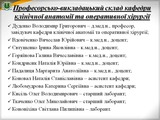
Methodical recomendation to topic No. 1Subject: Clinical anatomy and operativesurgery
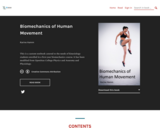
Short Description:
This is a custom textbook catered to the needs of kinesiology students enrolled in a first-year biomechanics course. It has been modified from OpenStax College Physics and Anatomy and Physiology.
Word Count: 158328
(Note: This resource's metadata has been created automatically by reformatting and/or combining the information that the author initially provided as part of a bulk import process.)

This course is designed to provide an understanding of how the human brain works in health and disease, and is intended for both the Brain and Cognitive Sciences major and the non-Brain and Cognitive Sciences major. Knowledge of how the human brain works is important for all citizens, and the lessons to be learned have enormous implications for public policy makers and educators.
The course will cover the regional anatomy of the brain and provide an introduction to the cellular function of neurons, synapses and neurotransmitters. Commonly used drugs that alter brain function can be understood through a knowledge of neurotransmitters. Along similar lines, common diseases that illustrate normal brain function will be discussed. Experimental animal studies that reveal how the brain works will be reviewed.
Throughout the seminar we will discuss clinical cases from Dr. Byrne’s experience that illustrate brain function; in addition, articles from the scientific literature will be discussed in each class.
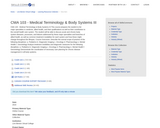
This course prepares the student to list major specialties in medicine, allied health, and their qualifications as well as their contribution to the overall health care system. The student will be able to discuss acute and chronic body system diseases, processes, and failures addressed by these major specialties and branches of allied health, as well as common treatment modalities for each system and how these might change throughout the lifespan.
Course Outcomes:
1. Describe the normal scope of practice of the following disciplines: a. Pediatrics b. Diagnostic Imaging c. Oncology d. Pharmacology e. Mental Health f. Gerontology
2. Analyze treatment modalities and diagnostic measures for the following disciplines: a. Pediatrics b. Diagnostic Imaging c. Oncology d. Pharmacology e. Mental Health f. Gerontology
3. Demonstrate the coordination of necessary care planning for chronic disease management in all body systems.
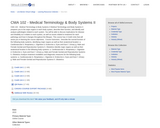
Medical Terminology and Body Systems II prepares you to list major organs in each body system, describe their function, and identify and analyze pathologies related to each system. You will be able to discuss implications for disease and disability as it relates to each system, as well as issues related to treatment for each pathology and how it changes throughout the lifespan. This course has 4 Credit Units that will assist you in learning the course objectives.
Course Outcomes:
1. Describe the normal function of the following body systems, identifying major organs as well as their anatomical location: a. Cardiovascular b. Respiratory c. Digestive d. Endocrine e. Eyes and Ears f. Urinary g. Male and Female Genital and Reproductive Systems h. Obstetrics
2. Identify major organs as well as their anatomical location in the following body systems: a. Cardiovascular b. Respiratory c. Digestive d. Endocrine e. Eyes and Ears f. Urinary g. Male and Female Genital and Reproductive Systems h. Obstetrics
3. Analyze treatment modalities and diagnostic measures for the following body systems: a. Cardiovascular b. Respiratory c. Digestive d. Endocrine e. Eyes and Ears f. Urinary g. Male and Female Genital and Reproductive Systems h. Obstetrics